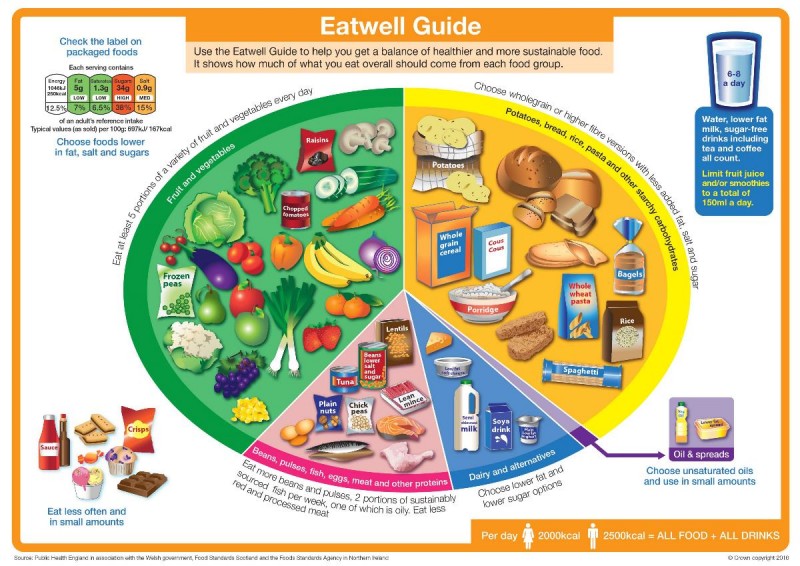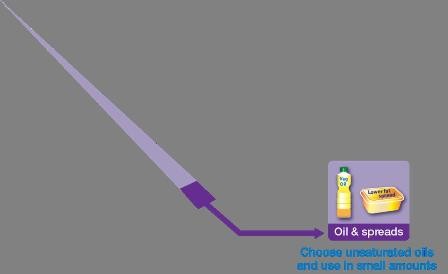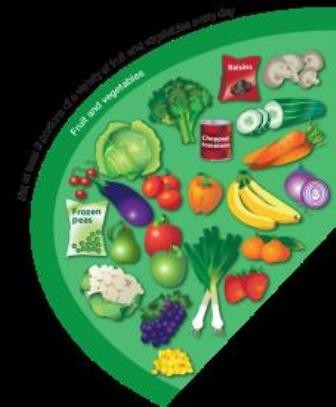Public Health England has launched a refreshed version of the UK’s healthy eating model which replaces the eatwell plate.
The Eatwell Guide has been developed from evidence based nutrition advice, and is designed in a pictorial form to help the communication of a healthy balanced diet to consumers.

An introduction to UK healthy eating guidelines
- UK food based dietary guidelines look to turn evidence-based scientific knowledge and government recommendations on foods, nutrients and health into simple messages to help consumers make informed choices about the foods, drinks and dietary patterns that promote good health.
- Food groups and foods/drinks that are sources of nutrients of public health importance when consumed in excess (like free sugars, salt, saturated fatty acids) or in insufficient amounts (e.g. dietary fibre) are considered.
- Guidelines aim to be appropriate for the majority of the population, culturally acceptable and practical, as well as easy to understand.
What is the history of models for healthy eating guidelines in the UK?
Around 20 years ago, in 1994, the UK’s national food guide, the Balance of Good Health was launched as a model to define the government’s advice on a healthy, balanced diet. It was revised under the Foods Standards Agency and renamed the ‘eatwell plate’ in 2007, and has been endorsed by the Departments of Health and Education in England; by the Scottish Government, the Welsh Government and by the Northern Ireland Executive. The responsibility for the eatwell plate transferred to Public Health England in April 2013.
The eatwell plate was a visual representation based on five food groups and showed the proportion that each food group should contribute to a healthy, balanced diet. The plate has been supported by further advice, the ‘Eight tips for healthy eating’. The guidelines were applicable to most of the healthy population. However it does not apply to those under 2 years of age, with children from the age of 2 to 5 gradually moving to eating foods in the proportions shown on the eatwell plate.
Why change the eatwell plate?
In 2014 Public Health England established an external reference group to consider the potential impact of new dietary reference values on the eatwell plate in light of, the then draft, conclusion and recommendations of the Scientific Advisory Committee on Nutrition’s Carbohydrate and Health report.
In 2015 the new recommendations for free sugars (no more than 5% of dietary energy) and fibre (an increase to 30g a day for adults), as well as the recommendation that the dietary reference value for carbohydrates be maintained at a population average of approximately 50% of total dietary energy intake, were accepted. PHE sought to ensure, as part of its role in promoting evidence based public health, that guidelines were aligned with delivery of a diet consistent with these new recommendations.
What are the main dietary messages of the new Eatwell Guide?
| Change | Why? |
|
Renamed the eatwell plate to the Eatwell Guide
|
The name better reflects its purpose, that of a guide to encourage a healthy diet. |
|
High fat, salt and sugars foods have been removed from the purple section
|
Foods high in fat, salt and/or sugars, which previously featured in the purple section of the eatwell plate, have been moved outside the main image. |
|
The purple segment now only contains ‘oils and spreads’
|
The Eatwell Guide differentiates unsaturated oils and spreads (e.g. plant/vegetable oils like rapeseed, olive, nut oils and lower fat spreads) from other foods that are high in fat, salt and sugars. |
|
Inclusion of a hydration message
|
Keeping hydrated is part of a healthy diet. Fluid recommendations are reinforced and the best choices of drinks are emphasised. |
| Fruit juice has been removed from the fruit and vegetable segment |
The advice around fruit juice and smoothies has now been encompassed within the drinks and hydration message. |
|
Updated segment names |
The names of food group segments have been updated For example, the pink segment is named ‘Beans, pulses, fish, eggs, meat and other proteins’ to place emphasis on certain food products within the food group that can be considered more environmentally sustainable. The change of name highlights the importance of plant based proteins to a sustainable, healthy diet. |
|
Food group segments resized
|
Segment sizes, including those of the starchy carbohydrate group and fruit and vegetables, have been adjusted. This is to reflect current government advice, and in particular the revised carbohydrate recommendations, on decreasing free sugars and increasing fibre as part of a healthy, balanced diet. |
|
Additional messages for further guidance |
Additional messaging for each food group in the image can be helpful to in providing information to consumers around healthier choices within each group, and are related to health benefits that these choices can make. |
|
Inclusion of energy requirements
|
The message that our daily energy intake comes from not only the foods we eat, but also from the drinks we consume is reinforced. |
|
Inclusion of a front of pack (FOP) nutrition label
|
Food labels can be used to help us choose foods lower in fat, salt and sugars when shopping, and so may make it easier to make healthier choices. |
Eat at least 5 portions of a variety of fruit and vegetables every day.
Base meals on potatoes, bread, rice, pasta or other starchy carbohydrates; choosing wholegrain versions where possible.
Have some dairy or dairy alternatives (such as soya drinks); choosing lower fat and lower sugar options.
Eat some beans, pulses, fish, eggs, meat and other proteins (including 2 portions of fish every week, one of which should be oily).
Choose unsaturated oils and spreads and eat in small amounts.
Drink 6-8 cups/glasses of fluid a day.
If consuming foods and drinks high in fat, salt or sugar have these less often and in small amounts.
What’s changed?
There are many similarities between the eatwell plate and the Eatwell Guide. It still shows the different types of food we should eat – and in what proportions – to have a healthy, balanced diet.
However, there are also some distinct differences shown in the table below.
How have consumers been considered in the guidelines?
Consumer research during the development of the guide underlies many of the changes that have been made.
This research showed:
- Those who are already engaged with food and nutrition tended to prefer photos, but those who are less engaged, and more likely to have a poor diet, preferred drawn images. In order to make the model accessible to the whole population, drawn images have been used, which tested well with all consumers.
- The plate with a knife and fork no longer resonated with the public, and the term ‘Guide’ was considered helpful.
- Placing foods high in fat, salt and sugars outside the main image was useful to facilitate understanding of their place in the diet (for example, as occasional foods or foods to eat less often or in small amounts), emphasising that these foods can be included but should be limited and not seen as part of the main healthy dietary pattern.
- The format of the wording and phrasing in the supporting messages understood by consumers, and that which was found to offer the greatest impact in guiding better choices.
- The inclusion of an energy message provided adults with a useful benchmark for their own consumption.
- Consumers felt there was a lack of guidance on choosing foods lower in fat, salt and sugars when shopping, precipitating the decision to include the front of pack label.
Source: www.nutrition.org.uk













